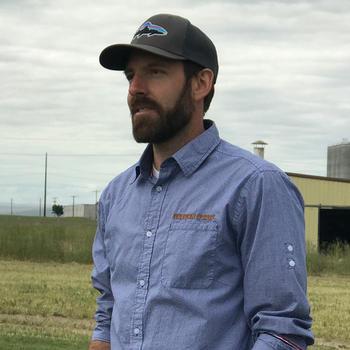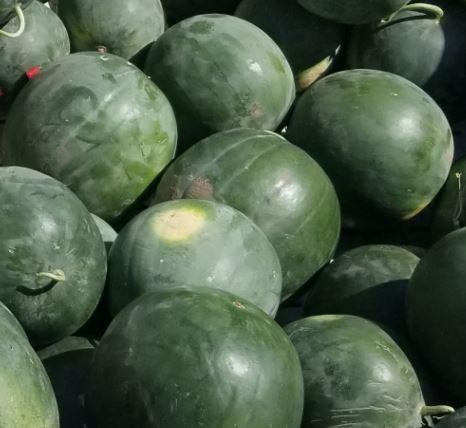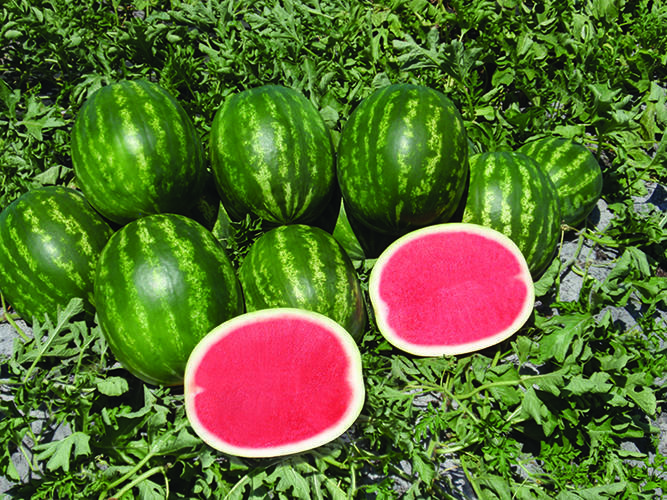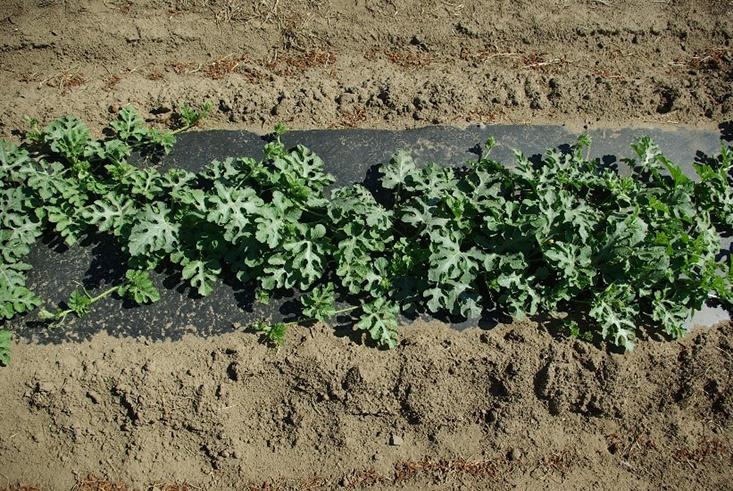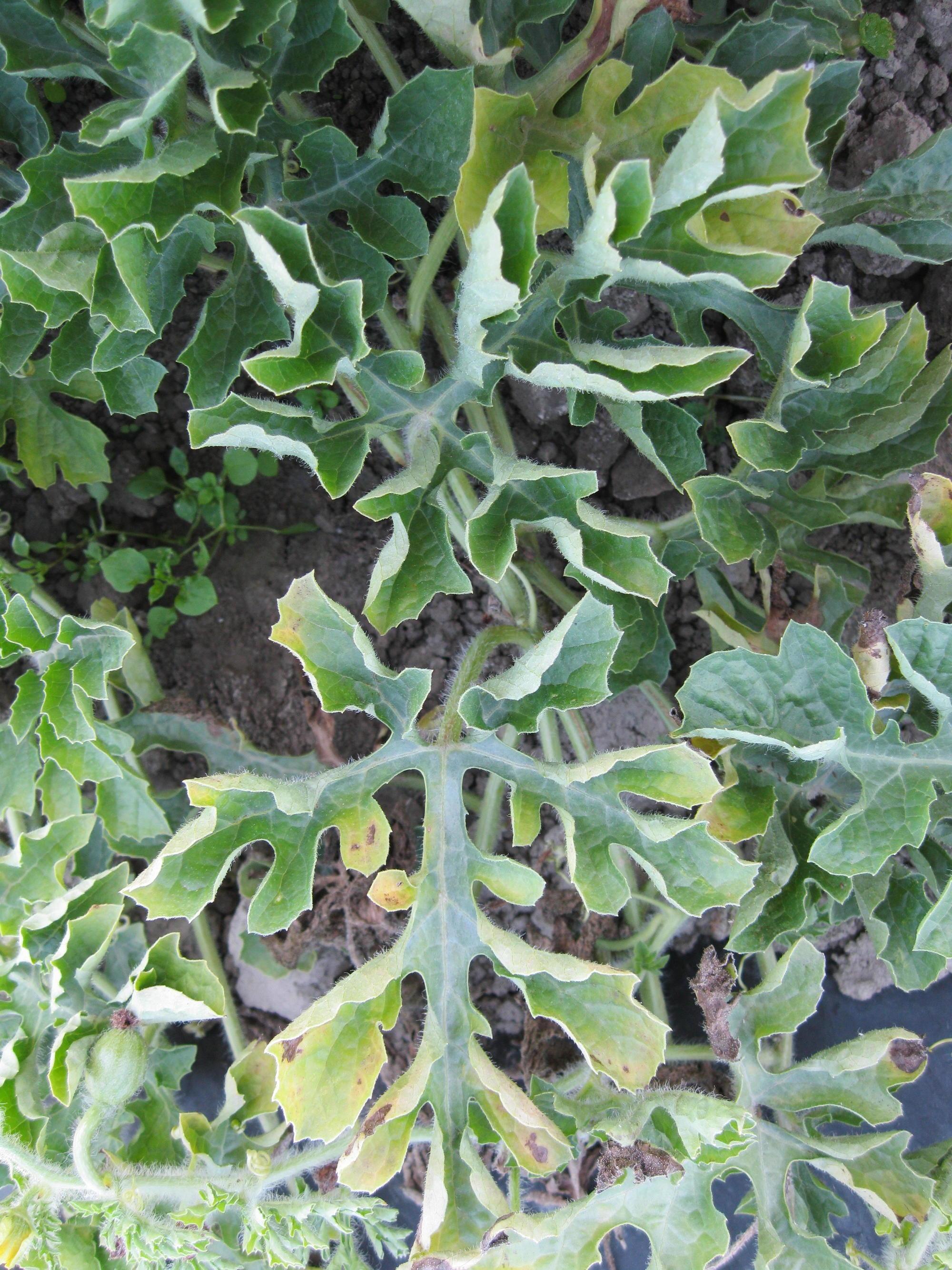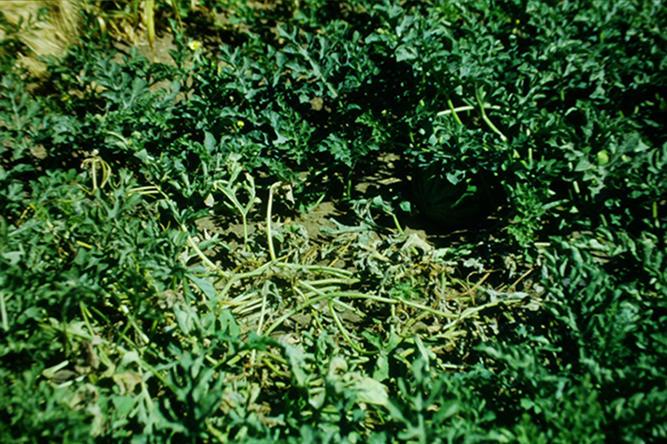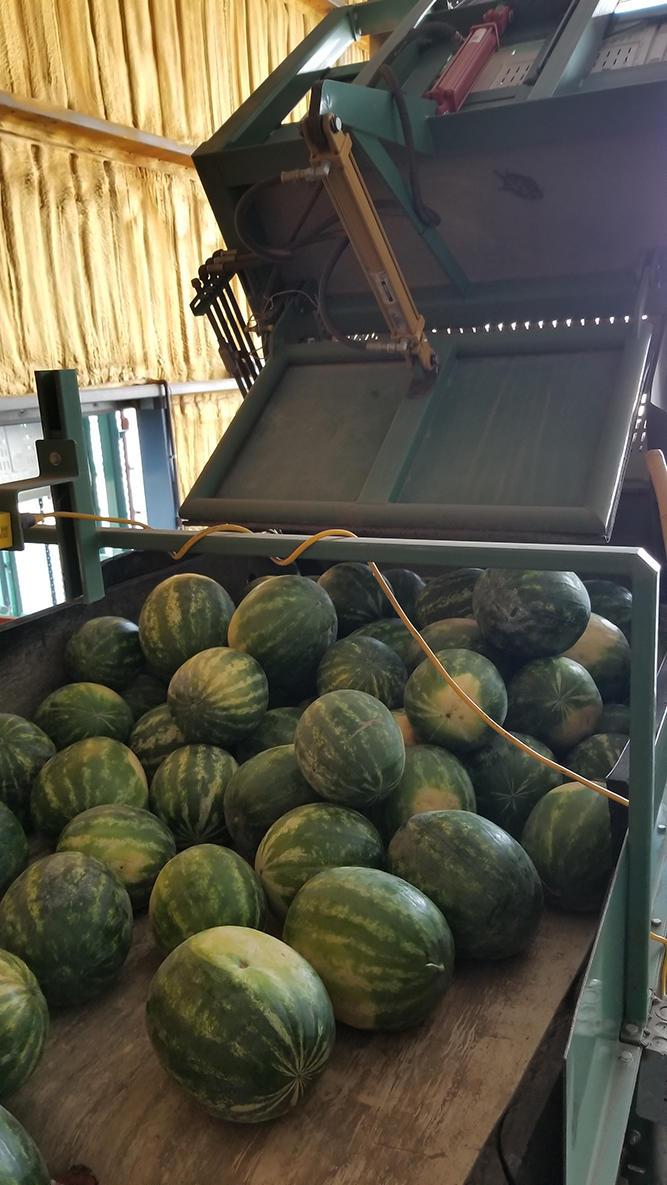Scott Lukas, horticulturalist and assistant professor, Hermiston Agricultural Research and Extension Center; Logan Clark, bio science research assistant II, Hermiston Agricultural Research and Extension Center; Kenneth Frost, assistant professor, Hermiston Agricultural Research and Extension Center; and Linda Brewer, senior faculty research assistant II. All with the Department of Horticulture, Oregon State University.
Watermelon in the Pacific Northwest
The warm, low-elevation fields of the Columbia Basin are some of the best places to grow watermelon (Citrullus lanatus). The Lower Umatilla Basin near Hermiston, Oregon, is the center of Pacific Northwest commercial production. Together, Oregon and southeastern Washington produce almost 2,000 acres of this popular fruit crop.
Although the region is a minor player in national watermelon production, Umatilla Basin watermelons are shipped throughout the Pacific Northwest and as far as Texas and Maryland. Current production in Idaho is limited to small-scale farms near the Hagerman Valley selling into local markets.
To meet peak market demand, commercial watermelon production is limited to areas with springtime temperatures warm enough to permit planting by mid-May. Optimal temperatures for growth of watermelon are 70–85°F; growth slows as temperatures rise above 95°F.
Cultivars
When you choose a watermelon cultivar, consider fruit size, estimated time to harvest, adaptation to local growing conditions, and intended market. Available cultivars produce fruit in a range of sizes, shapes and colors. The short list below is a summary of important characteristics of commonly produced cultivars adapted to inland Pacific Northwest production areas. (Figure 1).
- ‘Crimson Sweet’ is a staple, seeded cultivar with crisp texture and mild flavor.
- ‘Delta’ is a larger, more oblong, seeded cultivar with deep red flesh. It is a good pollinizer for seedless watermelon production.
- ‘Exclamation’ and ‘Fascination’ are seedless cultivars that produce uniform fruits that ship and store well (Figure 2). Both have intermediate resistance to the soilborne pathogen Fusarium.
- ‘Sangria’ is another standard, seeded cultivar with oblong shape and light-colored stripes. It has some resistance to Fusarium.
- ‘Sentinel’ is a large-fruited, seeded cultivar with a thick rind, making it ideal for long-distance shipping.
- ‘Sugar Baby’ is a small-fruited, seeded cultivar with sweet, deep red flesh.
Seedless or triploid watermelon cultivars are popular with consumers, leading to increased demand and production. Seedless cultivars are more expensive to produce but may demand a higher market price. Seed of seedless cultivars is expensive: $700–$1,200 per pound. Successful growers identify buyers to purchase and distribute seedless melons before taking on the added costs and risks associated with them. For more information on costs of producing watermelon, see 2013 Cost Estimation of Producing Seedless Watermelon in Eastern Washington (see “For more information”).
When choosing a pollinizer cultivar for seedless watermelon production, consider these points:
- Choose a seeded cultivar with fruits easily distinguished from the fruits of the seedless cultivar, to ease sorting at harvest.
- Optimize revenue by choosing a pollinizer cultivar with market appeal.
- Confirm that the pollinizer and main crop bloom periods overlap.
Common pollinizer cultivars include ‘Sugar Baby’ and ‘Sentinel’, but there are also specialized pollinizer cultivars such as ‘Wild Card’, ‘Ace’ and ‘SP-7’.
Pollination
An individual watermelon plant produces both male and female flowers. The male flowers produce the pollen and the female flowers produce the fruit (Figure 3). Flowers are viable only for one day. Studies indicate that female watermelon flowers must be visited an average of seven times by a pollinator insect to be completely pollinated. We recommend keeping pollinators in the field throughout the flowering period to optimize fruit production. Marketable fruit are only produced from completely pollinated flowers. Incomplete pollination can result in fruit that is aborted at the golf ball size or misshapen and unmarketable (Figure 4).
Growers commonly rent honeybee hives during flowering at the rate of one hive of bees per acre. Native bees also pollinate watermelon. Bees require water as they forage; provide fresh water near the field to encourage them to stay near the crop.
Because watermelon flowers are not the most attractive forage for honeybees, control nearby flowering weeds to reduce competition for pollination services. Apply any pesticides with caution to prevent injury to pollinators. Carefully follow product label recommendations and communicate with the beekeeper to limit the bees’ exposure. To learn more, see How to Reduce Bee Poisoning from Pesticides (see “For more information”).
To set fruit, seedless watermelons require pollen from a seeded pollinizer cultivar. Plant one seeded cultivar after every third seedless watermelon plant within a row. Across rows, stagger the pollinizers so that pollen sources are evenly distributed within the field. Pollinator insects tend to forage within rows. Interplanting pollinizers within the row results in more efficient pollination and fruit set compared to planting alternate rows of seeded and seedless watermelons.
Planting
Setting watermelon transplants in the field is almost always preferable to direct seeding. Transplants experience less disease pressure and abiotic stress than direct seeded crops and better compete against weeds. Further, germinating seed can become trapped under mulches and reduce the overall stand. Ensuring that the plants emerge through the hole in the mulch is a time-consuming process.
Direct seeding
Watermelons require 15–25 square feet per plant. Direct seeding is only recommended for open-pollinated (seeded) cultivars. For a direct-seeded crop, plant 1–2 pounds of seed per acre to establish a planting density of 1,200–1,700 plants per acre. Seedless cultivars often have germination and emergence issues and may grow less vigorously in the early season. For these reasons, seedless cultivars should be grown from transplants; direct seeding is not recommended.
Planting practices can have a significant impact on disease incidence. Planting fungicide-treated seed can reduce the risk of soilborne disease. Direct-seeded plants are more prone to damping off in cool, moist soils than transplants.
Transplant production
Greenhouse production of transplants increases seed-use efficiency, and transplants can lead to earlier harvests. Start watermelon transplants by placing 1–2 seeds per cell in 72-cell seedling trays or flats. Cell dimensions of 1–1.5 inches allow proper root growth and reduce the likelihood of transplants becoming root-bound. Use a well-drained, commercially available media mix.
When irrigating flats, water only when the soil is dry to the touch to the depth of your first knuckle and irrigate until the water drains freely from the bottom of the flat. Overwatering is a common problem in transplant production, but allowing plants to dry enough to cause wilting is also a problem. To reduce the risk of foliar disease, water in the morning so that foliage can dry before nightfall.
Damping-off can be a problem in transplant production. While transplants must be monitored for damping-off, its incidence can be reduced by scrupulously sanitizing the greenhouse, any tools used in transplant production and seedling trays with a dilute bleach solution. Attention to soil moisture and air circulation among the developing plants can also reduce damping-off. See “Disease” for more information.
Field-ready transplants should be healthy, dark green, and of appropriate size (1–3 true leaves). Transplants that are too large or that have suffered disrupted growth before out-planting will be slow to establish and likely reduce overall crop productivity.
Grafted transplants
Inspect purchased transplants carefully for signs of improper growing practices, disease or insect damage, yellow leaves, and flower formation. Expect to pay $0.28–0.35 per transplant, depending on the cultivar and your location. Transplants can be grafted onto rootstocks to add desirable characteristics, such as decreased disease susceptibility or improved cold hardiness. Grafted transplants cost more per plant but can reduce the need for soil fumigation and pesticide applications for disease management. The many benefits of grafted watermelons can justify the increased cost per plant.
To learn more about grafting watermelon seedlings, see Vegetable Grafting: Watermelon (see “For more information”).
Flat-grown transplants
Flat-grown transplants may require a complete fertilizer to ensure uninterrupted development. Apply small amounts of a liquid fertilizer every 7–14 days. Consider the amount of premixed fertilizer in the growing medium when calculating rates. Before transplanting in the field, allow the transplants to acclimate to outdoor conditions for 3–5 days by:
- Placing the planting trays outside for several hours in the morning, and
- Limiting fertilizer and water applications, but not to the point of wilting.
When transplanting in the field, place the root plug slightly deeper in the soil than it was in the seedling tray. Protect tender roots from drying out by covering all potting medium with field soil. Water as soon as possible after transplanting to ensure sufficient soil moisture and root growth.
Windbreaks
Young transplants and seedlings are prone to wind damage, so windbreaks are recommended. For grafted plants, keep the graft union at least 1 inch above the soil line.
The most common windbreaks are fall-planted winter wheat, rye or oats, or February-planted barley. Seed grain windbreaks at a rate of two to three seeds per inch.
An alternate strategy is to plant the entire field with the fall-seeded grain. In the spring, till strips in the grain for the watermelon rows at bed formation. This method provides a cover crop to scavenge nitrogen and stabilize the soil over the winter. You can cultivate grain windbreaks after watermelon establishment, or mow or rototill them into the soil, or chemically terminate them before vine development.
Take care not to allow watermelons to touch windbreaks; prolonged abrasion can damage growth or scar the melons.
Planting date and temperature
East of the Cascades, the planting dates for watermelon are typically April 10 to May 5, when the risk of hard frost is minimal. Watermelon seeds germinate when soil temperature is at least 60°F at a 2-inch depth. Germination rate and seed and seedling resistance to pathogen infection increase at soil temperatures above 70°F. Plant direct-planted seeds at a depth of 1 inch.
Soils
Well-drained sandy loam soils, like those found in the Columbia Basin, are ideal for watermelon production. Fields with a history of soilborne pathogens, such as Verticillium dahliae or Fusarium spp., may require fumigation, use of treated seeds, or grafted transplants to ensure a successful crop. Limiting cucurbit production (melon, squash, cucumber, etc.) within your crop rotation to once in five years will minimize soilborne disease and insect loads.
Do a soil test before field preparation to guide plant nutrient needs, soil amendment or other chemical applications. A slightly acidic soil with a pH of 6–6.5 is ideal for watermelon production. A soil pH of less than 5.8 may result in macronutrient deficiencies and micronutrient toxicities, such as manganese toxicity. If liming is required to maintain optimal pH, rates should always be based on a soil test, with lime applied the previous fall. Find more information on soil sampling, testing methods and interpreting soil test results in the publications A Guide to Collecting Soil Samples; and Soil Test Interpretation Guide (see “For more information”). The best time to incorporate pre-plant fertilizer or soil amendments is during the bed formation. See “Fertilizing.”
Site preparation
Watermelon are produced in beds 4 feet wide and 8–12 inches high. A mechanical bed shaper forms the bed and lays the drip tape and plastic in one pass (Figure 5). Drip irrigation tape is buried 3 inches below the soil surface and slightly off the center of the bed. Anchor both sides of the plastic with at least 6 inches of soil. Plastic mulch will increase soil temperature and reduce weed pressure within the row. Reduced weed pressure can lead to earlier harvest, higher profit and reduced herbicide application. There are many row cover options; 1.25 mil black polyethylene plastic is commonly used, but 1 mil or less probably provides the same benefits and is more cost effective.
The plastic and drip tape must be removed at the end of the growing season to reduce habitat for fungi and insects; this step is essential in certified organic systems. Conventional growers may use soil-biodegradable plastic mulch, but organic growers may not. In conventional systems, till soil-biodegradable plastic mulch into the soil along with the crop residue at the end of the growing season. See Important Considerations for the Use of Biodegradable Mulch in Crop Production; and Biodegradable Plastic Mulch and Suitability for Sustainable and Organic Agriculture (see “For more information”).
Spacing
Space rows 9 feet on center with in-row plant spacing of 3 feet (Figure 6). Smaller icebox cultivars can be spaced as closely as 2 feet with between-row spacings of 5 feet. Grafted cultivars produce larger fruit; growers have reported success with in-row spacing of 5 feet.
Irrigation
Watermelons develop deep and extensive root systems in sandy, well-drained soils. Crops in other soil types will require thoughtful irrigation planning to optimize root systems. Consistent irrigation that meets evapotranspirative demand by the crop will minimize water stress during vegetative growth, fruit set and fruit sizing periods. Excess irrigation can promote unwanted soilborne diseases.
Prior to harvest, monitor irrigation closely to avoid soil saturation and surface pooling of water. As the crop ripens, these conditions can result in fruit splitting, unsightly spots and fruit rot. Producers can expect to apply 15–25 inches of water depending on seasonal variation in temperature and precipitation and geographic area, soil type, surrounding land use, and irrigation method.
Drip irrigation under black plastic mulch can reduce water use by up to 30% and increase yields. Drip irrigation also allows direct application of nutrients and fertilizer through the drip lines, resulting in more precise delivery for root uptake.
Approximate summer irrigation needs for Hermiston production are:
- 3.5 inches in May.
- 5.0 inches in June.
- 7.5 inches in July.
- 7.0 inches in August.
Specific irrigation recommendations for several areas within the Columbia Basin, including Hermiston, are available throughout the growing season under the crop water use page on the Bureau of Land Reclamation’s AgriMet database. The evapotranspiration data from AgriMet will allow you to water your crop according to plant water need. Select the weather station closest to you for the estimated crop water use chart. (See Figure 7).
Fertilizing
Always submit soil samples for testing before fertilizing to ensure accurate fertilizer application rates.
The following full-season recommendations may help guide your fertilizer program:
- Nitrogen: 90–120 (N) lb/acre.
- Phosphorus: 50–80 (P2O5) lb/acre.
- Potassium: 60–120 (K2O) lb/acre.
- Sulfur: 30–50 (S) lb/acre.
Apply a fraction of the total N as a base granular fertilizer when you form the planting beds, and follow up with a soluble N source (urea ammonium nitrate or an organic emulsion) applied through the drip irrigation system on weekly or biweekly intervals. Apply no more than 20 pounds N per acre at each injection. Take care to avoid over-application of N fertilizer. Excess N can negatively impact watermelon flavor and may contaminate local water supplies with nitrate.
On some sites, watermelon production may benefit from specific micronutrient applications. Base application decisions and rates for micronutrients on a soil test.
See the publications A Guide to Collecting Soil Samples; and Soil Test Interpretation Guide (see “For more information”).
Pest management
The following pest management information is an overview of primary issues affecting watermelon production in the Pacific Northwest. For more detailed information, see the Pacific Northwest Pest Management Handbooks (see “For more information”).
Weeds
Establishing watermelon beds with a black plastic mulch alleviates weed pressure in the area directly surrounding the plant and reduces costs associated with weeding. Chemical and mechanical methods effectively control weeds between rows. You must apply herbicides between rows before the vines grow beyond the plastic mulch (Figure 8).
Apply herbicides at a low pressure using drift guard nozzles to reduce drift, increase precision of the spray and reduce damage to the crop. Air induction nozzles are recommended because they reduce unwanted chemical drift. Apply herbicides during cool, calm weather in morning or evening to avoid unintended effects on pollinators and reduce the risk of volatilization.
Insects
A variety of insect pests attack watermelon; this publication does not list them all. Field monitoring throughout the season allows you to identify problem insects before they damage the crop. Sticky trap cards and regular visual inspections are proven practices for pest monitoring.
Ants are a major pest of watermelon. They damage young stem tissues near the soil surface of freshly transplanted or recently germinated plants. Young plants wilt or drop leaves. Take even minor infestations seriously as ants can spread rapidly. Left untreated, ants can cause the need to replant, resulting in uneven harvest times across the field. If control is required, place bait stations in the holes of the plastic mulch and deliver insecticides via drip lines.
Aphids are a common, season-long pest on watermelons. Aphids puncture the phloem of the plant with their needle-like mouthparts to feed on plant sugars. At high densities, aphid feeding alone can injure plants. Also, aphids can transmit viruses through their feeding activities. Aphids shelter on lower leaf surfaces. Leaves on which aphids feed may wilt and curl downward. Generally, the economic threshold warranting treatment has been reached when 10% of all plants in the field are infested. Aphids can be treated with a wide range of conventional and organic insecticides. Biological control options such as lady beetles (ladybugs) also prey upon aphids and reduce their populations. For more information about insect biocontrol, see the publication Common Natural Enemies of Crop and Garden Pests in the Pacific Northwest (“For more information.”)
Several types of insect larvae may damage a watermelon crop, including armyworms, cutworms and wireworms. Armyworms (Spodoptera spp. and Mamestra spp.) feed on leaves, buds and fruit. Cutworms (Peridroma saucia or Agrotis ipsilon) feed on the stem. Armyworms are highly mobile on plants and generally move toward the center crown. Manage weeds as a first line of defense against armyworms. Mature female armyworms prefer lambsquarter (Chenopodium album) for egg laying. Tillage in the months prior to planting can reduce populations of armyworms overwintering in the soil.
Wireworms (Conoderus spp.) are the larvae of the click beetle. Wireworms are not active in the spring and fall; damage generally occurs from June to August. Wireworms feed on crop roots; damage usually appears as a localized feeding patch at the ground level of the plant. Even a moderate infestation can cause serious damage. Trap and monitor for wireworm by setting bait stations or by passing random soil and root samples through a screen to separate the larvae from soil. Wireworms are typically treated with soil fumigants; organic controls are available. See Wireworms: A Pest of Monumental Proportions (see “For more information”).
Thrips are very small, pale-yellow insects with an elongated body and fringed wings. They pierce the outermost layer of leaf tissue and feed on cellular fluids. Dense populations cause serious damage; leaf surfaces appear silvery or scratched. Much like aphids, thrips can spread disease. Control options for thrips are limited; 100% eradication is difficult to achieve.
Mites, most commonly spider mites, are slightly smaller than thrips. They are reddish-brown, and are more closely related to spiders and ticks than insects. These arachnids feed on plant sap. Their feeding produces foliage with a bronzed or bleached appearance and fine stippling. Left untreated, spider mite damage can reduce plant vigor and at higher populations, eventually cause death. Pesticide applications may kill beneficial insects that feed on mites, resulting in a rebound of mite populations.
Disease
Fungal, bacterial or viral pathogens can infect watermelons. Here are the symptoms of the most common diseases, with their control measures. A good precautionary measure is to test soils for the presence of these pathogens before planting the crop.
Alternaria leaf spot or leaf blight is caused by Alternaria cucumerina. Plant residues can harbor this fungal pathogen in the soil for up to two years; it spreads via wind and rain splash. The first symptoms occur on older leaves as small lesions with a yellow halo. Lesions on older leaves merge and eventually kill affected leaves. As the disease progresses, lesions spread to younger leaves. The fruits on affected plants have a dry, tough surface; flesh will be moist and spongy. Fruits may be more sensitive to sunscald due to defoliation.
Fusarium wilt is caused by Fusarium oxysporum f.sp. niveum, a common fungal pathogen occurring across the world in many soil types. Certain spore types produced by this pathogen can survive in soil for more than 15 years. The pathogen spreads within fields by rain splash or planting equipment, and moving infected transplants and seeds results in long-distance spread. Germinating pathogen spores infect the roots of healthy plants. Left untreated, fusarium wilt will colonize the vascular system of the plant and restrict xylem flow, resulting in wilting and eventual death (Figures 9a and 9b). Choose genetically resistant watermelon cultivars or transplants that are grafted onto resistant rootstocks. Optimal irrigation will reduce infection. Test soils for pathogen presence and avoid areas of the field with high pathogen plate counts. To find appropriate soil sampling and testing methods, see Analytical Laboratories Serving Oregon; A Guide to Collecting Soil Samples; and Soil Test Interpretation Guide (see “For more information”).
Verticillium wilt is caused by Verticllium dahliae, a soilborne fungus that infects many crop and weed plants. It can survive in the soil for more than 15 years. Like Fusarium wilt, Verticillium dahliae infects healthy plant roots and colonizes the vascular system of the plant. Moist soils favor root infection. Verticillium wilt is common in over-irrigated fields and in fields that receive high rates of irrigation in rotational crops. Symptoms include foliar chlorosis (leaves turn yellow and wilt). Foliar symptoms may first occur only on one side of the plant, but wilt progresses until the entire plant shows symptoms.
Management of Verticillium wilt is like that of Fusarium wilt. A pre-plant soil test is recommended to avoid fields with high soil infestations. Also avoid fields planted to potato, tomato or mint within the past five years. Fungicides generally do not control Verticillium wilt. The most effective way to manage this disease is with proper irrigation and fertility management, selection of resistant cultivars and transplants grafted onto resistant rootstocks, as well as soil fumigation.
Pythium spp. are the most common organisms to cause damping off, although Rhizoctonia solani and Fusarium spp. may also be present (and will worsen symptoms). Damping off can affect seedlings before or soon after emergence from the soil. Stems develop a necrotic lesion at the soil line, sometimes with a water-soaked appearance (Figure 10). This lesion quickly girdles the stem and causes seedling death. There is no control for damping off; pre-plant preventive measures are the only successful strategy. Wet soils promote damping off: Do not overwater, and avoid high-density plantings. There are several options for pre-plant control, including fungicide seed treatments, in-furrow application of mefenoxam at planting, or a soil drench of Streptomyces lydicus (Actinovate).
Downy mildew is caused by Pseudoperonospora cubensis and spreads by windblown spores. High humidity and moderate temperatures favor downy mildew infection and sporulation. This disease produces angular yellow lesions on the upper leaf surface and grey-purple, sometimes fluffy, growth on the leaf underside. Eventually, infected tissues turn brown.
Powdery mildew caused by Golovinomyces cichoracearum and Podosphaera xanthii is a common plant disease. These fungi require a living host to survive, so inoculum of this pathogen likely originates from infected plants in greenhouses or the field. Inoculum can be blown long distances. Warm temperatures and moisture favor initial infection, but fungal growth also occurs under dry conditions. The disease first appears as small white spots on leaves; these ultimately grow to cover the entire leaf. Infected leaves may eventually die; prolonged infection can stunt plant growth.
Papaya ringspot virus (virus family Potyviridae) affects most cucurbits. Papaya Ringspot Virus- Watermelon Type (PRSV-W) and Watermelon Mosaic Virus (WMV) are the most common viruses affecting watermelon. The main symptom of infection is a bumpy, mottled swirl pattern across the fruit surface. Leaves may be mottled and distorted. These symptoms are largely cosmetic in watermelon, but they do reduce sales. Economic loss in watermelon due to these viruses occurs when two or more viruses infect the same plant or when infection occurs early in plant development.
Physiological disorders
The most common physiological disorders in watermelons are blossom end rot, hollow heart and sunscald. The most common causes are environmental, genetic or crop management practices.
Blossom end rot is due to uneven irrigation that causes localized calcium deficiencies and misshapen fruits. Cold temperatures and incomplete pollination can also cause misshapen fruits. The most effective strategies against blossom end rot are consistent irrigation scheduling throughout the growing season and especially during fruit development, along with proper in-season nutrient management.
Hollow heart is another common defect that results in hollow or cracked internal fruit flesh. It may leave the fruit unmarketable. The cause of hollow heart is unknown, but research has suggested causes such as watermelon genetics, graft incompatibility, pollination and pollen viability, flower bloom time, decreased fruit tissue firmness, and environmental stressors such as heat, uneven irrigation and fertilization.
Sunscald or sunburn is caused by exposure of the melon rind to intense sunlight. Minimize fruit exposure by maintaining healthy foliage with good production practices. Shade melons at harvest by covering fruits with straw or watermelon foliage, especially between successive harvests. Drip irrigation will minimize water droplets on the fruit and may reduce sunscald.
Harvest
Watermelon yields in the Columbia Basin typically range from 15–30 tons/acre. Some growers report yields of 45–70 tons/acre with drip irrigation and plastic mulch. East of the Cascades, watermelon usually begins ripening early to mid-July; later harvests may occur into September. Watermelons do not continue to ripen off the vine; harvest only when they are sufficiently ripe for marketing. Ripened melons have:
- A yellow-cream color patch where the melon rests on the ground.
- A dry, brown tendril and leaflet nearest the node at the attachment point of the vine and the melon.
- Full sweetness and deep flesh color in cut melons.
Each variety has slightly different harvest indicators. Cutting melons open is a good way to gauge ripeness. At harvest, always cut melons from the vine — never pull. Pulling may damage the flesh at the attachment point. To avoid damage during harvest and storage, handle melons carefully and never stand them on end. Seedless melons tend to have thicker, more durable rinds that hold up better during handling and storage than seeded cultivars.
Marketing
Most of the watermelon produced in the U.S. is eaten fresh; they do not store for extended periods. To retain optimal quality, watermelons should be eaten within two to three weeks after harvest. Short-term storage, up to six weeks, is feasible under high humidity (90%) and at temperatures between 50 and 60°F. Quality of flavor and texture may diminish after two to three weeks.
Most Columbia Basin-grown watermelons are eaten regionally. Growers sell them to local distributors and grocery stores, or at farmers markets.
For more information
Oregon State University Extension Service https://catalog.extension.oregonstate.edu/
Common Natural Enemies of Crop and Garden Pests in the Pacific Northwest. EC 1613. Ambrosino, M. 2019.
Analytical Laboratories Serving Oregon. EM 8677. Andrews, S., D. Walenta, C. Sullivan, L. Henderson, and L. Brewer. 2017.
A Guide to Collecting Soil Samples. EC 628. Fery, M., J. Choate and E. Murphy. 2018.
How to Reduce Bee Poisoning from Pesticides. PNW 591. Hooven, L., R. Sagili and E. Johansen. 2013.
Soil Test Interpretation Guide. EC 1478. Horneck, D.A., D.M. Sullivan, J.S. Owen, and J.M. Hart. 2011.
Wireworms: A Pest of Monumental Proportions. EM 9166. Rondon, S.I., A. Vinchesi, A. Rashed and D. Crowder. 2017.
PNW Insect Management Handbook.
PNW Weed Management Handbook.
PNW Plant Disease Management Handbook.
Washington State University Extension Service https://pubs.extension.wsu.edu
Important Considerations for the Use of Biodegradable Mulch in Crop Production. FS304E. Chen, K-J., S. Galinato, C. Ghimire, S. MacDonald, T. Marsh, C. Miles, P. Tozer, and M. Velandia. 2018.
Biodegradable Plastic Mulch and Suitability for Sustainable and Organic Agriculture. FS103E. Cowan, J., C. Miles, D. Inglis, S. Ghimire, D. Hayes, and L. DeVetter. 2018.
2013 Cost Estimation of Producing Seedless Watermelon in Eastern Washington. FS150E. Galinato, S.P., C.A. Miles and J. Wimer.
Vegetable Grafting: Watermelon. FS 100E. Miles, C., L. Hesnault, S. Johnson, P. Krelder, and S. Dabirian. 2016.
Table 1. Common watermelon pests and treatment options.*
|
Pest |
Organic |
Conventional |
Biological control and |
|
Ants |
Diatomaceous earth; spinosad (Seduce) |
Bait stations (abamectin) and insecticide application via drip lines |
|
|
Aphids |
Rosemary oil; narrow range oils (Tritek) |
Dinotefuran; imidacloprid |
Ladybugs; silver reflective mulches |
|
Armyworms |
spinosad (Seduce); azadirachtin (Neemix) |
Insecticide (bifenthrin, permethrin, deltamethrin); Fumigant (1,3-dichloropropene) |
Tillage in months prior to planting; removal of lambsquarter (Chenopodium album) from field margins |
|
Mites |
spinosad (Seduce); |
Miticide (abamectin); |
Ladybugs, predatory mites |
|
Thrips |
spinosad (Seduce); azadirachtin (Neemix); concentrated garlic oil |
Rotation of pesticides (e.g., methomyl and diomethoate) |
Remove weeds before they flower |
|
Wireworms |
spinosad (Seduce) |
Insecticide (imidacloprid, bifenthrin, and avermectin) |
Bait stations for monitoring; root and soil samples for screening |
* Base management action on a threshold value of pest pressure. It is a violation of federal law to use any pesticide in a manner inconsistent with its labeling.
Table 2. Common diseases and treatment options.
|
Disease |
Symptoms |
Pathogen |
Treatment and |
|
Alternaria leaf spot or leaf blight |
Small lesions with yellow halo on older leaves |
Alternaria cucumerina (fungus) |
Streptomyces lydicus (Actinovate); azoxystrobin |
|
Damping off |
Stems water soaked at soil line, eventually traveling up the stem |
Pythium spp. (oomycete) |
Avoid overwatering and high-density plantings; Ridomil spray at base; soil drench in Actinovate |
|
Downy mildew |
Angular yellow lesions on top leaf surface; grey and sometimes purple fluffy growth on underside of leaf |
Pseudoperonospora cubensis (oomycete) |
Phosphonate formulations (group 33); copper (Koicide); Streptomyces lydicus (Actinovate) |
|
Fusarium wilt |
Yellow and wilted leaves |
Fusarium oxysporum f.sp. niveum (fungus) |
Pre-plant soil test; resistant cultivars and grafted transplants; fumigation |
|
Papaya ringspot virus |
Bumpy, mottled swirl pattern across fruit surface (largely cosmetic) |
Potyvirus sp. (PRSV-W) (virus) |
Vectored by aphids; control aphid population |
|
Powdery |
Circular powdery white spots on leaves and stems; first symptoms on upper surface of young leaves |
Podosphaera xanthii (fungus) |
Azadirachtin; wettable sulfur; copper (Koicide); Bacillus subtilis (Serenade-MAX) |
|
Verticillium wilt |
Yellow and wilted leaves |
Verticillium dahliae (fungus) |
Pre-plant soil test; resistant cultivars and grafted transplants |
This publication will be made available in an accessible alternative format upon request. Please contact [email protected] or 1-800-561-6719.
Published June 2020
Trade-name products and services are mentioned as illustrations only. This does not mean that the participating Extension Services endorse these products and services or that they intend to discriminate against products and services not mentioned.Use pesticides safely!
- Wear protective clothing and safety devices as recommended on the label. Bathe or shower after each use.
- Read the pesticide label—even if you’ve used the pesticide before. Follow closely the instructions on the label (and any other directions you have).
- Be cautious when you apply pesticides. Know your legal responsibility as a pesticide applicator. You may be liable for injury or damage resulting from pesticide use.
© 2020 Oregon State University.
Published and distributed in furtherance of the Acts of Congress of May 8 and June 30, 1914, by the Oregon State University Extension Service, Washington State University Extension, University of Idaho Extension, and the U.S. Department of Agriculture cooperating. The three participating Extension services offer educational programs, activities, and materials without discrimination on the basis of race, color, national origin, religion, sex, gender identity (including gender expression), sexual orientation, disability, age, marital status, familial/parental status, income derived from a public assistance program, political beliefs, genetic information, veteran’s status, reprisal or retaliation for prior civil rights activity. (Not all prohibited bases apply to all programs.) The Oregon State University Extension Service, Washington State University Extension, and University of Idaho Extension are an AA/EOE/Veterans/Disabled.
